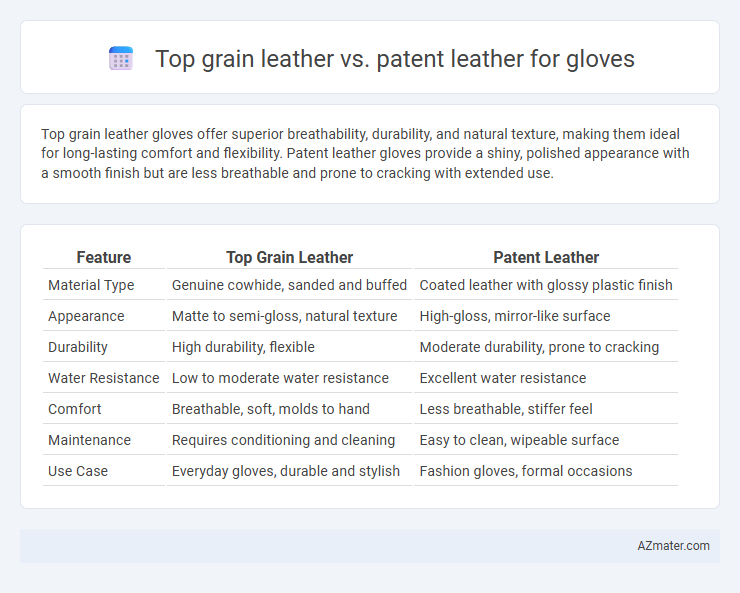Top grain leather gloves offer superior breathability, durability, and natural texture, making them ideal for long-lasting comfort and flexibility. Patent leather gloves provide a shiny, polished appearance with a smooth finish but are less breathable and prone to cracking with extended use.
Table of Comparison
| Feature | Top Grain Leather | Patent Leather |
|---|---|---|
| Material Type | Genuine cowhide, sanded and buffed | Coated leather with glossy plastic finish |
| Appearance | Matte to semi-gloss, natural texture | High-gloss, mirror-like surface |
| Durability | High durability, flexible | Moderate durability, prone to cracking |
| Water Resistance | Low to moderate water resistance | Excellent water resistance |
| Comfort | Breathable, soft, molds to hand | Less breathable, stiffer feel |
| Maintenance | Requires conditioning and cleaning | Easy to clean, wipeable surface |
| Use Case | Everyday gloves, durable and stylish | Fashion gloves, formal occasions |
Introduction to Top Grain Leather and Patent Leather
Top grain leather, derived from the uppermost layer of the hide, offers durability and a smooth, natural finish ideal for gloves requiring flexibility and breathability. Patent leather is characterized by its glossy, lacquered surface achieved through a coating process, providing a sleek appearance but less breathability and stretch compared to top grain leather. Choosing between these materials depends on glove use, with top grain leather favored for comfort and long-term wear, while patent leather suits formal or decorative purposes.
What is Top Grain Leather?
Top grain leather is a high-quality material created by sanding and refinishing the upper layer of the hide, providing durability, breathability, and a soft texture ideal for gloves. Unlike patent leather, which features a glossy, plastic-coated surface, top grain leather maintains a natural look with subtle grain patterns and better flexibility. This makes top grain leather gloves more comfortable and long-lasting for everyday use.
What is Patent Leather?
Patent leather is a type of coated leather known for its glossy, mirror-like finish achieved through a plastic coating that provides water resistance and easy maintenance. Unlike top grain leather, which retains natural grain and breathability, patent leather sacrifices some flexibility and natural texture for its high shine and durability. This makes patent leather gloves ideal for formal occasions where style and appearance are prioritized over comfort and breathability.
Key Differences Between Top Grain and Patent Leather
Top grain leather gloves offer durability, breathability, and a natural texture due to minimal surface sanding, making them ideal for long-term wear and comfort. Patent leather gloves feature a glossy, high-shine finish achieved through a coating process, providing a sleek aesthetic but less flexibility and breathability compared to top grain leather. The key differences lie in their finish, durability, and usability, with top grain leather focusing on toughness and natural feel, while patent leather emphasizes style and shine.
Durability: Top Grain vs Patent Leather Gloves
Top grain leather gloves offer superior durability due to their natural grain layer, which resists wear and tear while maintaining flexibility and breathability. Patent leather gloves, coated with a glossy finish, are less durable as the surface is prone to cracking and peeling over time under frequent use. Choosing top grain leather ensures longer-lasting gloves suitable for heavy-duty activities, whereas patent leather suits occasional wear with a focus on style.
Comfort and Fit Comparison
Top grain leather gloves offer superior breathability and flexibility, ensuring a comfortable fit that molds to the hand over time, while patent leather gloves provide a sleek, glossy finish but tend to be stiffer and less breathable, potentially causing discomfort during extended wear. The natural texture of top grain leather allows for better moisture absorption and enhanced dexterity, crucial for precision in glove use. Patent leather's rigid surface can restrict movement and cause sweating, making top grain leather the preferred choice for optimal comfort and fit.
Appearance and Aesthetics
Top grain leather gloves exhibit a natural matte finish with subtle texture variations that emphasize a luxurious, classic appeal ideal for sophisticated looks. Patent leather gloves offer a high-gloss, mirror-like shine that creates a bold, eye-catching aesthetic perfect for formal occasions and fashion-forward statements. The choice between the two hinges on the desired visual impact, with top grain leather highlighting understated elegance and patent leather delivering striking brilliance.
Maintenance and Care Requirements
Top grain leather gloves require regular cleaning with a damp cloth and conditioning with leather-specific products to maintain suppleness and prevent cracking. Patent leather gloves demand gentle wiping with a soft, damp cloth to preserve their glossy finish and occasional use of a patent leather cleaner to avoid scuffs and discoloration. Both types benefit from proper storage away from direct sunlight and moisture to extend their longevity and appearance.
Price and Value Consideration
Top grain leather gloves offer a balance of durability and breathability, typically priced higher due to superior material quality, making them a valuable investment for long-term use. Patent leather gloves, characterized by their glossy finish and lower price point, provide a stylish appearance but may lack the same level of comfort and longevity. Buyers seeking cost-effectiveness and elegance often choose patent leather, while those prioritizing durability and premium feel prefer top grain leather despite the higher initial cost.
Which Leather is Best for Gloves?
Top grain leather offers superior breathability, durability, and a natural texture, making it ideal for gloves that require flexibility and comfort. Patent leather, with its glossy finish, is less breathable and more prone to cracking, which can limit glove longevity and comfort. For gloves, top grain leather is generally the best choice due to its balance of toughness and breathability.

Infographic: Top grain leather vs Patent leather for Glove
 azmater.com
azmater.com